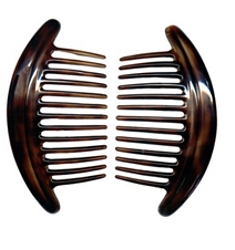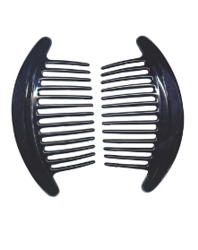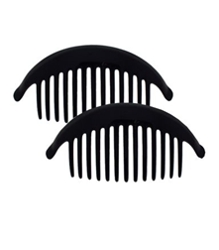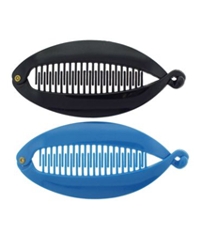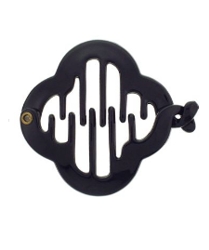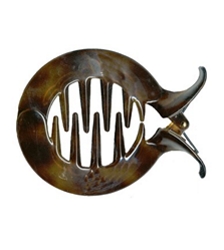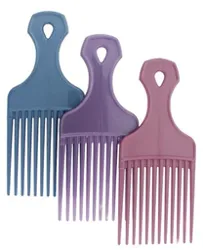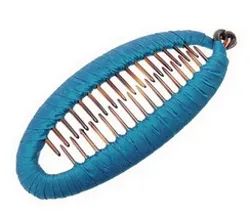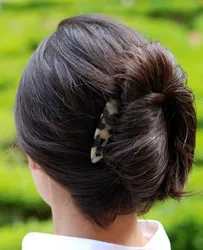
Interlocking Combs - How To Use
Interlocking Combs
Hair combs have been around since humans figured out how to use tree branches and twigs as a way to style their hair. Initially combs were used to detangle tresses and arrange hair into styles.
Eventually hair combs evolved from use in detangling and styling to a tool for securing hair from the face and up on the head.
Hair combs were used in matched comb sets or individually. Hair combs used to secure or decorate hair were referred to as side combs. When sides combs were part of a set designed to work in unison by interlocking, they were called interlocking combs.
How Interlocking Combs Are Connected
interlocking combs may or may not be connected to each other by means of a hinge, snap or similar. They can be standalone.
interlocking combs, even when not connected to each other by a hinge, are designed so that the teeth interlock and hold a hairstyle in place.
The use of interlocking combs to create a range of updos or half up/half down hair styles extends back to the 1960s, 70s and 80s. Hair combs come in all shapes and sizes. They are made from a variety of plastics since the combs have to be flexible and have some bend.
How To Use
Scoop hair back on both sides of your head at temple and bring together in the back locking combs firmly in place with amazing holding power.
Hair combs can also be swept under the back of your hair, bringing both up evenly to the crown and then interlocking them, creating a full, cascading appearance. Great for medium to thick hair.
They can be used as a single comb to anchor a traditional French twist, as double comb anchors for a ballerina or similar style buns or in a variety of creative hairstyles.
They can be positioned horizontally or vertically depending on the thickness, length, fullness and texture of the hair being styled.
What Is The Ideal Hair Type, Texture, Length For Interlocking Combs
Hair combs work best for hair which is long enough and thick enough to be pulled up into a full updo or a half up/half down hairstyle.
Ideally there has to be thick enough hair to allow the combs to snap into place in the hair.
Someone with medium to thick curly or wavy hair is an ideal candidate for interlocking hair combs. Hair combs need hair grip. Therefore hair which is fine, thin, super soft or slippery may have some challenges getting the combs to lock together.
Even if you get the combs positioned properly if your hair is too soft or slippery the combs may, in some cases slip over time.
If you want to wear the interlocking combs as decorative accessories rather than as functional combs they can be positioned over bobby pins set in an X profile.
The combs, if they tend to slip and slide out of the hair, can be anchored by well placed bobby pins.
How To Buy
Some of the best interlocking combs are hand crafted in France from cellulose which is a form of the highest quality plastic.
French combs are the longest lasting with strong individual teeth. Less expensive versions may have teeth which break easily. French combs generally have smoother, hair friendly teeth.
Remember when shopping for interlocking combs it's important to understand if they are standalone or hinged together.
Always determine if you are getting a set of two or are required to buy two individual combs to lock together.
Cellulose Versus Hot Plastic
Depending on the French manufacturer, combs are hand cut from large sheets of cellulose rather than poured into hot plastic molds.
Combs which are not French are often made from molds of plastic rather than hardy cellulose.
Be aware that some distributors sell interlocking combs individually rather than in a set of two. Keep that in mind when comparing prices. Always check to make sure you're getting two combs in a set rather than just one.
Styling Products And Interlocking Comb Teeth
In some rare cases, if you wear a lot of styling products, the color on the teeth on these combs, over time, may possibly become slightly faded due to the interaction with some styling products, especially those with a heavy alcohol content.
It's always best to put your combs in after you've applied your styling products and they've had a chance to dry.
Difference Between Interlocking Combs And French Twist Combs
French Twist combs were designed to be inserted into the seam or side of a traditional vertical hair twist.
French Twist combs are not designed to be interlocked although two French Twist combs can be used together. Since some French Twist combs have wavy teeth, it's not possible to interlock them.
French Twist combs are different than popular side combs which tend to be smaller and can be worn in set of two.
Summary
Hair combs - both standalone and hinged - have been around for many years and are never out of style. They can be utilized in a wide range of updos and hairstyles from a simple ponytail to a full blown updo.
They can be worn together or individually. Hair combs come in a variety of sizes, shapes, colors and price points.
They are manufactured around the world, but are famous for their French origins where they tend to be hand crafted from the highest quality materials.
Although interlocking combs offer the option to be creative with styling new hairstyles, they work best for hair which is shoulder length or longer and medium thick to very thick.
They are ideal for hair which is naturally curly, wavy or textured.
Why am I such a fan of interlocking combs? They are one of my own personal favorite hair accessories. They're functional, efficient and just plain fun to wear.
Social Media Network Information
Please follow us on Twitter at: https://Twitter.com/HairBoutique. I look forward to meeting new people from all walks of Twitter and learning from their Tweets.


